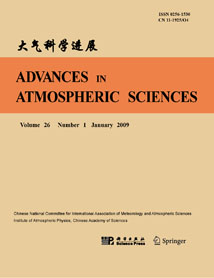| [1] |
Yujie WU, Wansuo DUAN,
2018: Impact of SST Anomaly Events over the Kuroshio-Oyashio Extension on the "Summer Prediction Barrier", ADVANCES IN ATMOSPHERIC SCIENCES, 35, 397-409.
doi: 10.1007/s00376-017-6322-0
|
| [2] |
Ben TIAN, Hong-Li REN,
2022: Diagnosing SST Error Growth during ENSO Developing Phase in the BCC_CSM1.1(m) Prediction System, ADVANCES IN ATMOSPHERIC SCIENCES, 39, 427-442.
doi: 10.1007/s00376-021-1189-5
|
| [3] |
HU Ruijin, LIU Qinyu, WANG Qi, J. Stuart GODFREY, MENG Xiangfeng,
2005: The Shallow Meridional Overturning Circulation in the Northern Indian Ocean and Its Interannual Variability, ADVANCES IN ATMOSPHERIC SCIENCES, 22, 220-229.
doi: 10.1007/BF02918511
|
| [4] |
Zhang Qin, Zhu Yufeng, Ni Yunqi,
1995: QBO Features of Tropical Pacific wind Stress Field with the Relation to El Nino, ADVANCES IN ATMOSPHERIC SCIENCES, 12, 87-94.
doi: 10.1007/BF02661290
|
| [5] |
Zhengyu LIU,
2006: Glacial Thermohaline Circulation and Climate: Forcing from the North or South?, ADVANCES IN ATMOSPHERIC SCIENCES, 23, 199-206.
doi: 10.1007/s00376-006-0199-7
|
| [6] |
WANG Shaowu, ZHOU Tianjun, CAI Jingning, ZHU Jinhong, XIE Zhihui, GONG Daoyi,
2004: Abrupt Climate Change around 4 ka BP: Role of the Thermohaline Circulation as Indicated by a GCM Experiment, ADVANCES IN ATMOSPHERIC SCIENCES, 21, 291-295.
doi: 10.1007/BF02915716
|
| [7] |
LI Shuanglin, CHEN Xiaoting,
2014: Quantifying the Response Strength of the Southern Stratospheric Polar Vortex to Indian Ocean Warming in Austral Summer, ADVANCES IN ATMOSPHERIC SCIENCES, 31, 492-503.
doi: 10.1007/s00376-013-2322-x
|
| [8] |
LIN Pengfei, LIU Hailong, ZHANG Xuehong,
2007: Sensitivity of the Upper Ocean Temperature and Circulation in the Equatorial Pacific to Solar Radiation Penetration Due to Phytoplankton, ADVANCES IN ATMOSPHERIC SCIENCES, 24, 765-780.
doi: 10.1007/s00376-007-0765-7
|
| [9] |
HU Ruijin, LIU Qinyu, MENG Xiangfeng, J. Stuart GODFREY,
2005: On the Mechanism of the Seasonal Variability of SST in the Tropical Indian Ocean, ADVANCES IN ATMOSPHERIC SCIENCES, 22, 451-462.
doi: 10.1007/BF02918758
|
| [10] |
FU Jianjian, LI Shuanglin, LUO Dehai,
2009: Impact of Global SST on Decadal Shift of East Asian Summer Climate, ADVANCES IN ATMOSPHERIC SCIENCES, 26, 192-201.
doi: 10.1007/s00376-009-0192-z
|
| [11] |
FAN Lei, Zhengyu LIU, LIU Qinyu,
2011: Robust GEFA Assessment of Climate Feedback to SST EOF Modes, ADVANCES IN ATMOSPHERIC SCIENCES, 28, 907-912.
doi: 10.1007/s00376-010-0081-5
|
| [12] |
Juan AO, Jianqi SUN,
2016: The Impact of Boreal Autumn SST Anomalies over the South Pacific on Boreal Winter Precipitation over East Asia, ADVANCES IN ATMOSPHERIC SCIENCES, 33, 644-655.
doi: 10.1007/s00376-015-5067-x
|
| [13] |
ZHOU Lian-Tong, Chi-Yung TAM, ZHOU Wen, Johnny C. L. CHAN,
2010: Influence of South China Sea SST and the ENSO on Winter Rainfall over South China, ADVANCES IN ATMOSPHERIC SCIENCES, 27, 832-844.
doi: 10.1007/s00376--009-9102-7
|
| [14] |
WU Fanghua, LIN Pengfei, LIU Hailong,
2012: Influence of a Southern Shift of the ITCZ from Quick Scatterometer Data on the Pacific North Equatorial Countercurrent, ADVANCES IN ATMOSPHERIC SCIENCES, 29, 1292-1304.
doi: 10.1007/s00376-012-1149-1
|
| [15] |
YU Yongqiang, ZHENG Weipeng, WANG Bin, LIU Hailong, LIU Jiping,
2011: Versions g1.0 and g1.1 of the LASG/IAP Flexible Global Ocean--Atmosphere--Land System Model, ADVANCES IN ATMOSPHERIC SCIENCES, 28, 99-117.
doi: 10.1007/s00376-010-9112-5
|
| [16] |
ZhouTianjun, Zhang Xuehong, Yu Yongqiang, Yu Rucong, Liu Xiying, Jin Xiangze,
2000: Response of IAP/ LASG GOALS Model to the Coupling of Air-Sea Fresh Water Exchange, ADVANCES IN ATMOSPHERIC SCIENCES, 17, 473-486.
doi: 10.1007/s00376-000-0037-2
|
| [17] |
Jin Xiangze, Huang Ruixin, Yang Jiayan,
1999: Centennial Oscillations in an Ocean-ice Coupled Model, ADVANCES IN ATMOSPHERIC SCIENCES, 16, 323-342.
doi: 10.1007/s00376-999-0012-5
|
| [18] |
FU Jianjian, LI Shuanglin,
2013: The Influence of Regional SSTs on the Interdecadal Shift of the East Asian Summer Monsoon, ADVANCES IN ATMOSPHERIC SCIENCES, 30, 330-340.
doi: 10.1007/s00376-012-2062-3
|
| [19] |
FuZuntao, Zhao Qiang, QiaoFangli, Liu Shikuo,
2000: Response of Atmospheric Low-frequency Wave to Oceanic Forcing in the Tropics, ADVANCES IN ATMOSPHERIC SCIENCES, 17, 569-575.
doi: 10.1007/s00376-000-0020-y
|
| [20] |
FENG Junqiao, HU Dunxin, YU Lejiang,
2012: Low-Frequency Coupled Atmosphere--Ocean Variability in the Southern Indian Ocean, ADVANCES IN ATMOSPHERIC SCIENCES, 29, 544-560.
doi: 10.1007/s00376-011-1096-2
|















 AAS Website
AAS Website 
 AAS WeChat
AAS WeChat 
 DownLoad:
DownLoad: